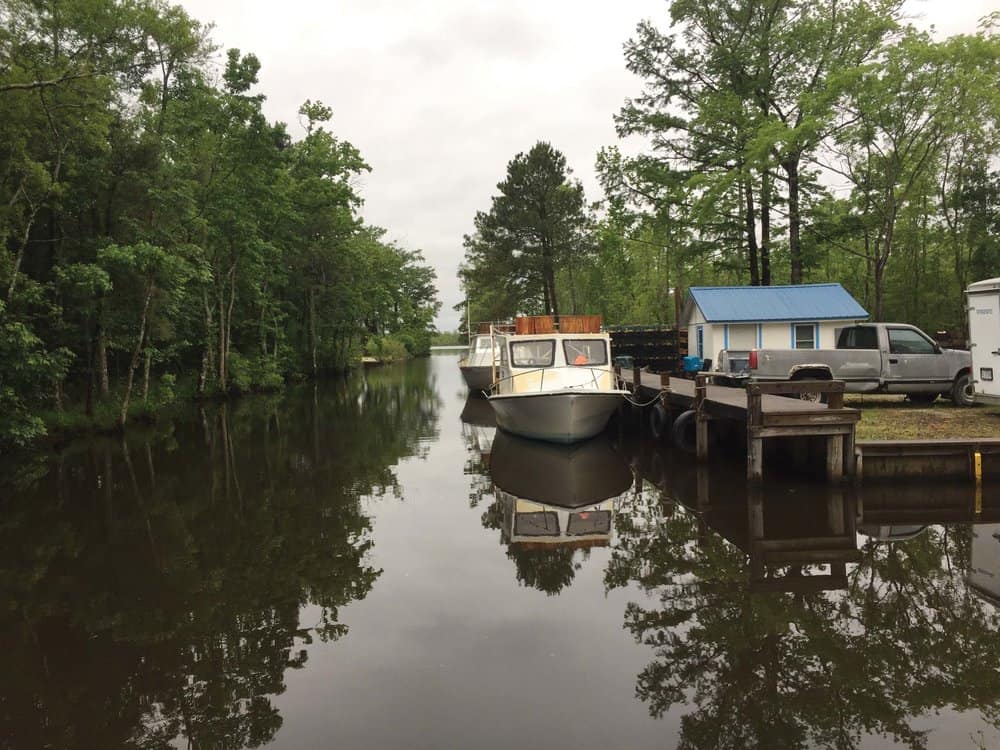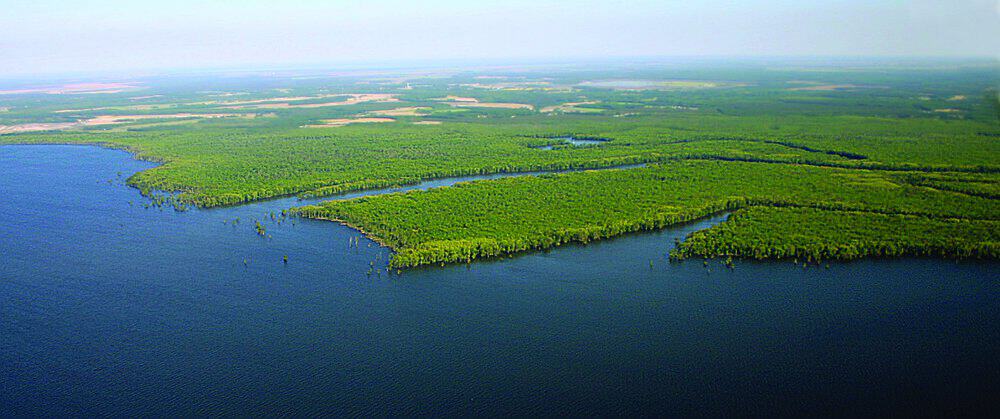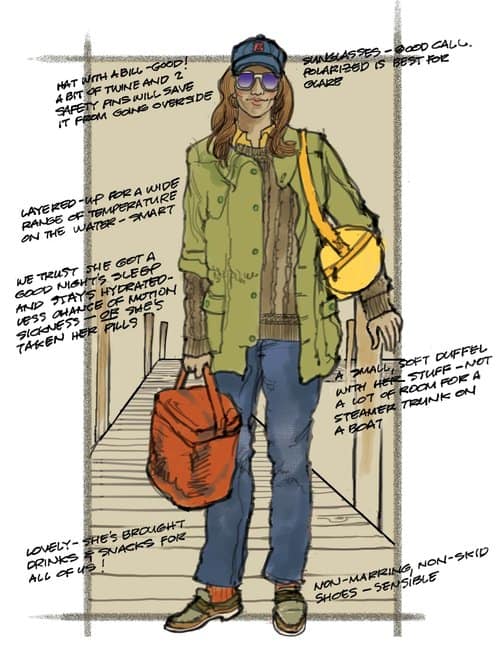by Jody Argo Schroath
The Albemarle Loop spins a notorious piece of water into a cruisers’ playground. Our Cruising Editor gives it a whirl.
The first obstacle to my opening day on the Albemarle Loop was the weather, which is to say it wasn’t good. It was, in fact, exactly the sort of weather we are warned against by every cruise guide author (including myself) writing about North Carolina’s Albemarle Sound. Northwest winds 15 to 20 knots, and a fetch the length of Rhode Island had accordioned the Sound’s shallow water into its signature steep chop, while some mischievous god atop a solid gray blanket of cloud was hurling down rain like javelins. Not what the forecast had called for, of course, but then this was the Albemarle, known for its sudden outbursts of meteorological mayhem.
“By this time,” wrote veteran cruiser and guide writer Fessenden Blanchard in 1954 after his first crossing, a rough one, “I began to think of Delaware Bay as a mill pond.” Crossing the sound a month later by car, he marveled at the placid water and was surprised it was still placid when he got to the other side.
“What were those people who came up with the Loop thinking?” I asked Sammy, Ship’s Dog No. 2, who was soggy but steadfast in his post in my helm chair. Bindi, Ship’s Dog No. 1, had long since retired to the warm dry cabin below.
Travelers on the Intracoastal Waterway, which crosses the Sound north to south, are advised to get across the Albemarle as quickly as possible, preferably in the early morning or late afternoon when the winds are likely to be better. But the organizers of the Loop have a different idea altogether. They use the enticement of free dockage at nine marinas across the sound to persuade cruisers to linger on the Albemarle and spend days and days lolling about, visiting one enchanting little town after another. And, oddly perhaps, it’s been working. The reviews from A-Loopers have been enthusiastic.
“Why not?” I too had said. After all, I was still basking in the warmth and balmy breezes of southern Florida.
“Why not, indeed!” I said now as I galumphed along through the chop, wind and rain.
THE LOOP
I had left River Forest Marina in Belhaven, N.C., at about 6:00 that mid-May morning and cleared the Alligator River Swing Bridge early in the afternoon in the company of half a dozen returning ICW snowbirds. There the wind, pelting across the Sound, had met us, and the rain began in earnest. My ICW companions opened their throttles and made a beeline north toward the shelter of North River and the Virginia Cut, while I turned northwest to round Long School Point and begin my Loop.
What is the Albemarle Loop? It is a loosely organized group of nine marinas that offer up to 48 hours of free dockage to participating cruisers. The core group in no particular order is Albemarle Plantation Marina, Edenton Harbor Marina, Columbia Municipal Marina, Hertford Bay Marina, Dismal Swamp Visitor Center, Plymouth Landing Marina and Elizabeth City Mariner’s Wharf. The remaining two facilities are subject to change. For 2017, these are Pelican Marina in Elizabeth City and Manteo Town Docks. You can find information on all of them at www.albemarleloop.com.

The logical way to do the Loop, I suppose—and the method I used—is to follow along the shoreline one way or the other, depending on whether you are northbound or southbound, stopping at each marina/town in order. The complication is Manteo, which is at the far east end of the Sound while everything else is to the west. It’s a complication worth the effort, however, because Manteo is a charming place and the site of the first English attempt at settlement and exploration of the New World, Roanoke Island.
I didn’t go to Manteo this time because I’ve been there a couple of times already, including an entertaining stay one Halloween night at the Town Docks, and I wanted to concentrate on the places I’d never been. I also didn’t go up the Pasquotank River to Elizabeth City (two earlier visits) [see “Swamp Fever,” October 2010] and then up the Dismal Swamp Canal to the Rest Area (three visits) because the canal was closed. Happily, the canal is projected to reopen late this year.
My first stop was to be Columbia, 20 miles up the Sound and an additional five up the Scuppernong River. The entrance channel to the river is wasp thin, but well-marked, and the channel broadens for the rest of the trip, as the Scuppernong winds decoratively through woods and scrub to Columbia. The town docks lie tucked in a wide spot on the eastern shore, just before the U.S. 64 bridge (vertical clearance 12 feet).
As I made my approach to the short bulkhead space open between a Cal 25 and the end of the town bulkhead, the Cal 25’s owners came out to take my lines. The two friends had arrived the day before from Oriental, N.C., and were off the next day to Elizabeth City. “Doing the Loop?” I asked hopefully. “No,” they replied, “just off to try somewhere new.” Here the rain resumed, and my new friends hustled into the shelter of their cabin. I quickly set two spring lines and made my own retreat.
COLUMBIA

I spent two days in Columbia, which I found to be a thoroughly intriguing place, despite the fact that it rained, drizzled or simply poured the entire time I was there. Columbia is a very small town (population 900), the only incorporated municipality in Tyrell County, North Carolina’s least populated.

In Tyrell County, what is not river or sound is either woodland (85 percent) or pocosin, a kind of slightly elevated marshland (highest point 16 feet above sea level). Tyrell’s pocosin supports not only a remarkable population of plants, like the rose-crested orchid and yellow pitcher plant, but also black bears and red wolves—though not so many of these anymore—and alligators, of course. It’s not for nothing that Tyrell’s eastern border is the Alligator River. And any ICW traveler who’s looked for a place to anchor knows just how wild that is.

Early that evening, in a fine drizzle, the dogs and I stepped off the boat and into the 1950s. Walking Main Street, dead still in the growing dusk, we passed a pharmacy and barbershop that looked as if they hadn’t skipped a beat since opening their doors half a century ago. A block and a half in, however, the dogs and I nearly leapt off the pavement. A distinctly predatory looking red wolf was staring at us through a plate-glass window. Gathering up my scattered sangfroid, I realized we were looking at a taxidermied wolf in the window of the Red Wolf Coalition.
The preservation of red wolves is a recurring theme in Columbia, and I stared down a second inanimate example the following day as I toured the Walter B. Jones Sr. Center for the Sounds, which I initially took to be a one-of-a-kind auditory-based facility. The Center for the Sounds is located along a wonderful boardwalk, the Scuppernong River Interpretive Trail, that stretches from the marina, under the highway 64 bridge, and out into the pocosin. In these rainforest conditions, everything was lush and blooming.

But now, I hustled the dogs past the Main Street wolf, passing the old Columbia Theater and its Cultural Resources Center, a couple of antiques shops, and Pledger Hardware.

When I visited Pledger the next day, Wanda Snell Davenport, the bookkeeper and lifelong resident, first asked me if I’d seen the old bear trap hanging on the wall near the entrance. No, I hadn’t, I said, but looked for good measure. I countered by asking about the store. When the hardware opened in 1948 , it was called Pledger Brothers Hardware, she said, but after many years, one of the brothers left to open an auto parts store just across the street, and Brothers was dropped from the name. The company was still Pledger Hardware, but its president was now Robert “Frankie” Davenport, who had been working there since 1966 when he was 16. As Wanda and I chatted, Davenport was busy doing what hardware presidents do best: pulling out some arcane piece of equipment that was just what the customer had been hoping against hope to find.
I left Pledger Hardware toting my own arcane piece of equipment (I forget what it was) and crossed the street to visit the Pocosin Arts School of Fine Craft, whose window display eschewed stuffed predators and bear traps in favor of a wide variety of arts and crafts, from metalwork and pottery to mixed media and fabrics.
Inside I met metalwork jewelry artist Laurel Fulton of Denver, Colorado, who was just completing an artist residency. It was a wonderful program, she told me, both for the artists and for the children and adults who attend classes at the school. She introduced me to Claire Keatley, who had come as an artist in residence and stayed as director of programs and marketing. The school, privately funded from donations and foundations, provides art programs for the local school as well as wide range of workshops for adults.
On subsequent strolls, Bindi, Sammy and I turned off 1950s Main Street and strolled through Columbia’s 1950s neighborhoods. On Elm Street, we passed tidy cottages from the 30s and modest Victorians from the Teens. Here and there, a superabundance of spring flowers spilled exuberantly over prim white picket fences. On Water Street, we passed an old ice house. Broad Street ended at an old canal that provided launch and tie-up space for local watermen. Out on highway 64, a former fire station now housed the thoroughly 21st century Vineyards on the Scuppernong and its tenant, Elements Cafe. Elements’ owner Gabriella Crail and her mother Shari Crail serve coffees, teas and fresh pastries, sandwiches and a nice variety of local products and wine. No matter the century, it was all delightful!
PLYMOUTH
And that is the way the rest of my Loop trip went as well: A little bit of travel on the Sound, a trip up a river, puzzling out of the best place to tie up with Moment of Zen’s 15-foot beam, then a little exploration in town.
The next town along the Loop was Plymouth, six miles up the Roanoke River and on the far side of a 50-foot fixed bridge. It is a fascinating town, bookended by two museums and two lovely parks. The first contains the Roanoke River Museum, a replica 1886 Roanoke River Lighthouse and the town docks, while the second boasts a seagoing model of the Confederate ironclad CSS Albemarle and Port O’Plymouth Museum, housed in an old railroad station. Plymouth was the scene of the second largest Civil War battle in North Carolina and the South’s last victory. Consequently, the Port O’ Plymouth Museum has one of the finest collections of Civil War artifacts anywhere.
It was in the Port O’ Plymouth park that I met Billy Hassell, enthusiastic Plymouth resident, bass club founder and 30-year resident. Billy was walking the park docks, enjoying the day and thinking about where he was going to try his luck first during the next day’s bass tournament. “Right about there, just beyond the bridge pilings,” he told me. His wife was across the street in the Plymouth farmers market, presiding over a table laden with jars of homemade jams and tins of rum cake. I bought a cantaloupe. Now I wish I’d bought a rum cake too.
EDENTON

In Edenton, it rained the first day of my visit, but on the second, the clouds gave way to sunshine. Edenton is a beautiful city no matter what the weather. It is, without doubt, the star of the Albemarle Loop. A person could walk two dogs around its streets for five or six years and never tire of admiring its scores of historic homes, a treat to the eye, lovingly cared for, graceful and elegant in their finely detailed architecture. Its main street is bustling and prosperous, with a ladie’s dress shop and a cinema, a Peebles, library, coffee shop, a few grand and historic public buildings and a generous sprinkling of restaurants. Down by the water, there is a park and playground and the restored original 1886 Roanoke River Lighthouse.
Edenton was a particularly busy place the day the sun came out, first because it was Sunday and second because it was Mother’s Day. I spent some time poking in and out of shops and then watched the fun from the vantage of Zen’s cockpit. The town marina is right off the park, and there is a walkway along the top of the breakwater where people come at dusk to watch the sunset. The sunsets are very good.
ALBEMARLE PLANTATION
The day after Mother’s Day, I was back on the water and heading for Albemarle Plantation. It was almost odd to find myself in an actual marina. And Albemarle Plantation is a very nice one, with a friendly and helpful dockmaster, James Darnell, to take the lines and to show me around the place, from the clubhouse to the pool to the golf course and the tennis courts, all of which are available to Loop cruisers during their stay.
Albemarle Plantation also was the only place to get fuel, and I happily planned to take advantage of that fact. When the diesel pump failed to operate, James worked and worked to get it going. He even called in a friend to help.
The friend turned out to be Jack Atwell, the organizer of this whole Albemarle Loop project. Atwell, in turn, credits Donna Stewart of the Dismal Swamp Welcome Center for coming up with the idea of towns and marinas banding together to attract cruisers out onto the Albemarle. In any case, heroically, Darnell and Atwell got the diesel working again, and I was on my way again the next morning.
HERTFORD
My last stop along the Loop was more like a touch and go. The pleasant town of Hertford lies 11 miles up the Perquimans River, only a few miles east of Albemarle Plantation. But the river is bisected by a fixed bridge with a 33-foot vertical clearance—much too low for Zen’s 48 feet. So when I reached the bridge, I turned around and headed back out to the Sound, where I turned east to rejoin the ICW at North River, about 17 miles away. At 8 o’clock that night, at the end of a very long day, I lassoed a cleat at Top Rack Marina in Chesapeake, Va. I was back on the Bay.
In June, I drove to Hertford by car to see what I had missed. I drove across the town’s S-shaped swing bridge, the only one in the country—and maybe the world, who knows? I visited the Jim “Catfish” Hunter Museum. And I concluded my visit with lunch at the Brew 2 Rescue Cafe, whose profits support the fight against human trafficking. I also walked down to see the town docks, which are located on the upriver side of the S-bridge, behind the police station, in a small park. They looked very pleasant. I was sorry to have missed them.
FINAL NOTES ON THE LOOP
Whenever we travel by boat, we see towns and cities from an altogether different perspective. We never pass a strip mall or a fast food restaurant. We never wait at a stop light. We simply step off the boat and into the heart of town. In this way, we have no idea whether the town is remote from the rest of the world or on a main artery. The city we see stands alone. Baltimore, Norfolk, St. Michaels, it all works the same.
And in that regard, the Albemarle Loop is no different.
But here’s where I found the Albemarle Loop different, though it may just be my fancy. When I turned west toward Columbia, I left not only the ICW traffic behind, I left all the boat traffic behind. Mile after mile, day after day, I saw no other boats out on the water. Pretty soon, I left behind the VHF radio traffic as well. All of it. Then my cell phone reception dropped away. Now I couldn’t even call anyone. It was an odd and not altogether unpleasant experience.
The cell phone thing, however, was a bit tricky since nowhere I visited except Albemarle Plantation seemed to use the radio. I compensated by calling ahead each time from the previous town or whenever I did have a signal to arrange dockage. And since it happened that no one else was doing the Loop at the moment, dockage was never a problem.
A word about the docks. For some reason, towns tend to build short narrow slips not suitable for many of the cruising boats they want to attract. But they do usually include a T-head or two that will work for pretty much anything. This is the case in Plymouth, Edenton, and Hertford. The others, like Columbia, Elizabeth City, Dismal Swamp Rest Area and Manteo, have bulkheads that work equally well. The exceptions are Albemarle Plantation and Pelican Marina, which have floating docks and accommodations for larger boats.
So, is the Albemarle and all its towns as remote as they seemed to me? I don’t know the answer to that question. Probably no more than Oxford, Onancock, Crisfield and Chestertown. Still, it’s more romantic to think that they are.



